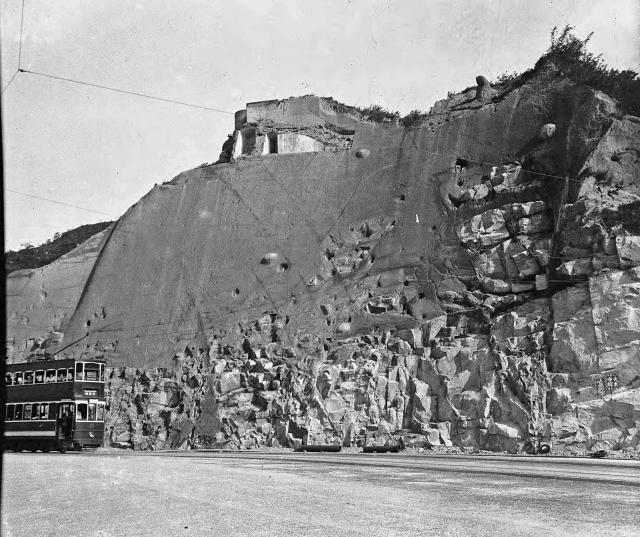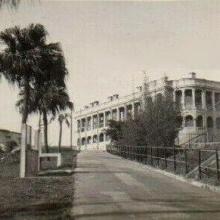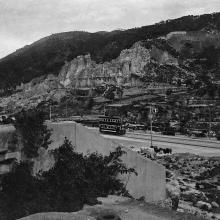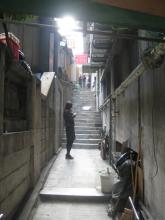Source: University of Wisconsin (uwm) here
Photographer: Pendleton, Robert Larimore, 1890-1957
Stereo photography , right hand side shown
Photographer's Note: Hong Kong. Deep weathering, Taika [Hei Ling Chau (island)]
This is at the tram line, my guess is King's Road in North Point. Not sure what the demolished building on top of the cliff is. A similar view is here.





Comments
Location?
Could it be here?
Tai koo
i wonder if the "Taika" note was a mistype of Taikoo? Could be somewhere around Quarry Bay/Taikoo (similar terrain here) - this could be the bend in the road at Quarry bay (far background in my linked image). Or perhaps the bend that was in King's Road where today's Kornhill development straddles the road?
Taikoo/King's Road
Phil, that is a good proposal.
The 1929 Public Works Department Annual Report refers:131. Road from Causeway Bay to Quarry Bay (Section 70 feet wide) opposite M.Ls. 430 and 431.—The old road to Sau Ki Wan traversed an area, which, after negotiation, was included in M.Ls. 430 and 431 it therefore became necessary to undertake the construction of this new road so as to make the whole of the lots available to the owner.(Update: this refers to North Point Reclamation-see comment below).So the photo likely shows that new road which straightens the bend in King's Road. The rocks look quite unweathered, so it fits with 1931. Today it's King's Road near the junction with Yau Man Street.
On top of the cliff there are ruins of a building. South of the road there was the old Police Station, possibly the ruins of one of the minor buildings are visible.
Today
If the 1931 photo shows the proposed area, this is how it looks today (opposite direction).
Re: Taikoo / King's Road
Hi There,
Not quite. I remember trams still going up and down the bend at Taikoo in the 1960's and early 1970's. Could not recall exactly when it is running by today's course, but it would be a great undertaking to remove the whole bluff. I suspect it would have something to do with the retirement of the dockyard\redevelopment of Taikoo Shing, the MTR Island line, as well as the sub-sequent development of the residential estates around Kornhill.
I guess some Tram buffs could come up with something.
T
1931 New Tram Tracks- Causeway Bay to Quarry Bay
Some of the 1931 photos show the photographer on the northern side of the tram tracks looking south. The double-lining of the track system in 1930/31 is mentioned here on Page 11
The scene from 1945 from North Point Power Station (Senior Staff Quarters) looking east.
King's Road
Thomas is correct, the bend in the middle where Kornhill now stands was there until into the 1980's. The same image I linked to above can be seen here as the beginning of a sequence of the car driving the same area. If you look at the end of the sequence you can see the bend when the cliff was still there, and this was in 1960. I can't give an exact date but I suspect the building of the MTR a Tai Koo was one of the main factors because exit A is slap bang where the cliff would have been located at the bend in the road.
I was erring on the other end of the road being the bend in the image i.e. where Mt Parker Road joins with King's Road. It was just a guess, nothing more, as I am not very familiar with how this area looked...perhaps Geoff (Wellstead) might be able to help pin it down?
Re: King's Road dockyard bend
Hi there,
That location was one of those where tram drivers twist their throttle handles to the extreme and went speeding. The other two such locations were Wong Nei Chung Road and the old Queensway with the S Bend. Quite a thrill is you stay in front on the top deck with the window down.
T
Re: New Road
Don't think the new road at that time went as far as the Dockyard as Quarry Bay normally refers to the Sugar Refinery.
Re: New Road
Unfortunately we don't know the location of M.Ls. 430 and 431, but I'm referring to the new road at the Sugar Factory shown on the 1952 map (hkmaps.hk show it already on the 1934 map). Here the old road is shown as a dotted line.
Marine Lots 430 and 431
The captioned marine lots refer to the North Point Reclamation as shown here and here The reclamation was completed in 1930.
1929 Tram Track System
Mention is made here of the tram track system in 1929. Interesting to note that the tramline between Quarry Bay to Shaukiwan had been double-lined previously. However, the portion between Causeway Bay and Quarry Bay remained a single line. To improve the tram service, a double line was being laid down along the causeway between Causeway Bay and Ah King's Slipway.
Photos of the tramlines near the Sugar Refinery at Quarry Bay can be viewed here
Very good discovery. I'm
Very good discovery. I'm quite sute that the cut through the hill is shown on this photo.
Same Scenes
The road cutting shown in the original photo can also be viewed here and here
Deep Cutting on King’s Road in Quarry Bay Village
Just created a place for the Deep Cutting on King’s Road in Quarry Bay Village.
Looking at the photos that show the cutting, I'm not sure if the Granite Formation photo is directly related to this place. The surface of the slopes of the cutting looks smooth while the one of the Granite photo is still pretty rough. It was probably taken further north where road works were announced in the Hong Kong Daily Press, 1929-05-07.(see moddsey's comment above)
Re: Granite Formation Photo
In this photo here of the same scene, a building can be seen peeking out at top left. This may help to narrow down the location. Perhaps the building to the north of Braemar Reservoir, near the Government Quarry as seen on the 1928 map from http://www.hkmaps.hk/mapviewer.html
Taikoo/Kornhill
The present tramline at Kornhill was built by 1986 in line of the MTR Island Line, eastbound trams running via King's Road naer the dockyard whilst westbound trams used the new line, i.e. both trams did not meet. About end-1987 the new east line was completed and the redundant tracks at King's Road were left until late 90s.